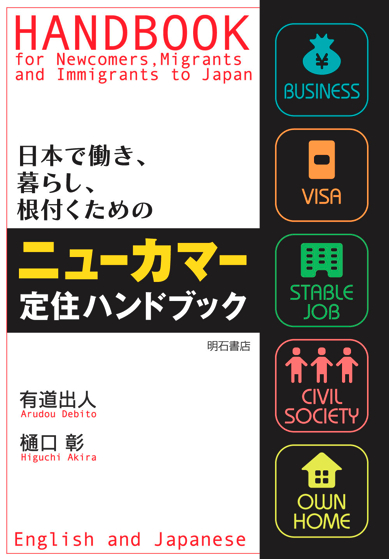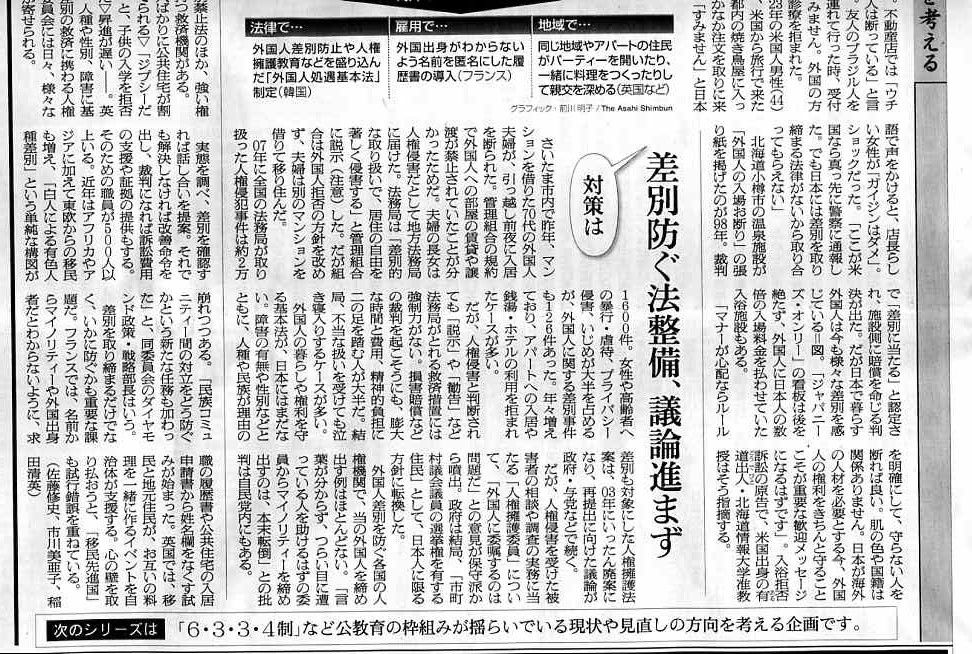mytest






Hi Blog. Had a couple of telephone interviews with the Asahi this week, and some quotes got incorporated into a tidy big article on discrimination against NJ in Japan in what should be done about it. Have a read. Good illustrations too — get the point across. Arudou Debito in Sapporo
(click on images to expand in your browser)
ENDS


5 comments on “10月5日朝日新聞(朝)「後絶たぬ『外国人お断り』」Oct 5’s Asahi on NJ discrimination and what to do about it”
its a great story, good work and write-up its about time this discrimination is talked about..because there is a big problem here in japan and it needs to be addressed..the newspaper should make this a weekly topic of discussion and not just a once every blue moon story..bravo to asashi for provideing this story..and it needs to be put on the front page since this is more news worthy then the stupid banana diet craze..
I know I saw a very similar siz e and style of cartoon in a Japanese paper, maybe Asahi, a few weeks ago while visiting a friend’s house and without my camera 🙁
Except it’s theme was 2-sided on how gaikokujin and Japanese could improve relations,
saying both sides had to do things.
Of course the contrast was a bit ridiculous. The Japanese were supposed to end housing discrimination. In return gaijin should stop having loud parties at home [as we ALL do, don’t you know! And what is “loud” anyway? Any noise that gives a racist, paranoid, or just plain insane neighbor an excuse to call the police? but I digress]
And a few other contrasts, in each case, the Japanese obligation was to basic human rights, or matters of extreme importance such as providing medical translation services; and the gaijin “obligations” were stupid, lame racist perceptions like being careful about sorting our garbage [ after all, Japanese people always seperate their garbage perfectly!], or being sure to say aisatsu to our neighbors.
I’m pretty sure another was that Japan should make access to public schools easier for gaikokujin, whereas gaijin should try to send their kids to school [uh, I don’t think that’s the big problem, is it?]
It was very sad that it seemed like whoever was responsible for the cartoon probably thought they were being genuinely helpful, but ended up just exposing their own racism.
Wish I could remember which paper and issue, I think it was around O-Bon, definitely a major paper. Osaka edition if that matters.
Level 3,
Oh god yeah. I’ll stop having loud parties (no problem because I’ve never had one) if the couple above me stop fighting and throwing stuff around at 3 am every night.
Or vacuuming at 1am!
I agree that the cartoons were useful. They didn’t attempt to draw ethnic stereotypes, they admit that “gaijin” is a discriminatory label, they represented a number of situations where discrimination takes place (like on the train or bus), and places responsibility firmly in the hands of the discriminators. A lesser article would have tried rationalizing the discrimination (“When the Japanese person on the train gets up and walks away when you sit next to them, they’re probably worried that they won’t be able to help them when you ask them a question in English”) or blaming some vague concept (“because of cultural differences…”)
Personally I’d like to see this kind of illustration in the ethics textbooks used at schools. The stories I’ve seen so far tend to be wishy-washy with light and fluffy happy endings.
Kudos to the Asahi for this one.